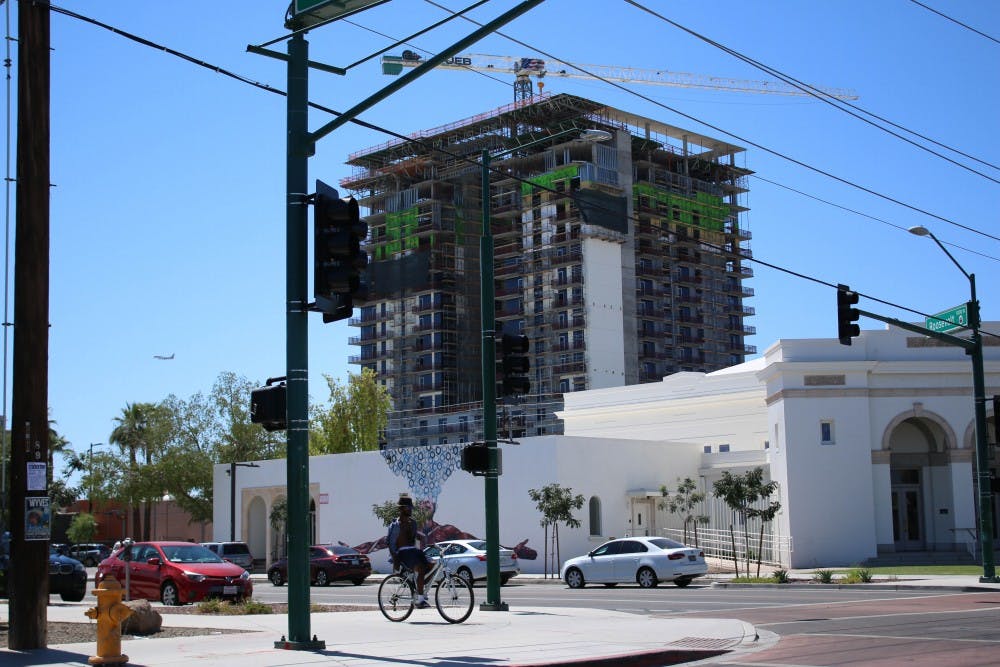ASU's Downtown Phoenix campus came to be in 2006, and the multi-million dollar project has emerged as a partnership between the City of Phoenix and the University since the conception of its idea in 2003.
“Prior to ASU being (in) downtown, Phoenix was about as dead as a door nail,” Interim Phoenix Mayor Thelda Williams said. “Streets were rolled up at 6 o’clock, there was no traffic, few places to eat and other than perhaps some sporting events, there really wasn’t any reason to be downtown.”
In 2000, well before ASU came to downtown Phoenix, the city had low economic values according to city data. However, current data is starting to look up as median household income, housing values, income and population have all risen while unemployment has dropped a total of about 35 percent from August 2003.
“A real city has begun to appear,” said Wellington Reiter, special adviser to ASU President Michael Crow and former dean of ASU’s College of Architecture and Environmental Design. Reiter said he was called upon by Crow in 2003 to help design and create a vision for the campus.
Now, downtown Phoenix is beginning to feel the full force of ASU’s over 11,000 students enrolled in the downtown campus. With a goal of 15,000 students by 2020, the campus is on the path to steady growth and expansion.
The addition of the Thunderbird School of Global Management will bring more graduate and executive education students to the downtown campus as well. Set to begin construction soon, the school moved from its previous home in Glendale to the downtown and west campuses to become fully integrated into ASU.
“Thunderbird has an international reputation, a global focus and (an) alumni network that is very active,” Jay Thorne, executive director of partnerships and external relations at the Thunderbird School, said. “It will brand Phoenix in a completely different way than other colleges do.”
Williams said that Thunderbird's relocation will attract visitors and investments from around the world which will provide technological benefits for Phoenix and beyond.
However, this growing campus did not come to be without the help of the city of Phoenix and its voters. In 2006, the voters approved $223 million in bond money to fund parts of the campus and the City Scape Park.
Rick Naimark, the associate vice president for program development planning, said the money, which came from Phoenix voters' property taxes, was approved by the Phoenix voters and the city council of Phoenix.
Naimark was the deputy city manager of Phoenix at the time of ASU Downtown's birth.
Because of ASU’s standing as a public university, it is able to use funds from the state and the public to fund its development, educational programs and day-to-day operations. The school, at its inception, created an intergovernmental agreement with the City of Phoenix that “lays out the broad nature of the relationship that was approved by the City Council and the Board of Regents,” Naimark said.
The city and school also had entered into a master lease with the city that allows ASU to use certain city properties that were acquired for the purposes of the development of the University, according to Naimark.
Known for being number one in innovation in 2017 according to US News, ASU does not only brand itself as such, but the city of Phoenix does as well.
“We are very proud of the partnership,” Williams, said. “We are now known for innovation and for attracting the high tech companies. It’s paying off for all of us.”
ASU is also a research university, and through its research it has helped the city with problems such as homelessness, sustainability, weather protection and more. Reiter and Williams both said the school is doing a lot of research for issues that they are passionate about.
See more: ASU teams up with Phoenix in competition to fight climate change
“Without ASU, it would be very expensive and much more difficult to do the research and work they are doing for the city,” Williams said.
Interlacing the University with the heart of the city has proven to be a worthy investment for Phoenix and its citizens, Naimark said.
“It was everything we wanted to do as the City of Phoenix to get ASU to become a major presence in the downtown community,” he said.
Reach the reporter at mlshuman@asu.edu or follow @mackenzieshuman on Twitter.
Like The State Press on Facebook and follow @statepress on Twitter.





